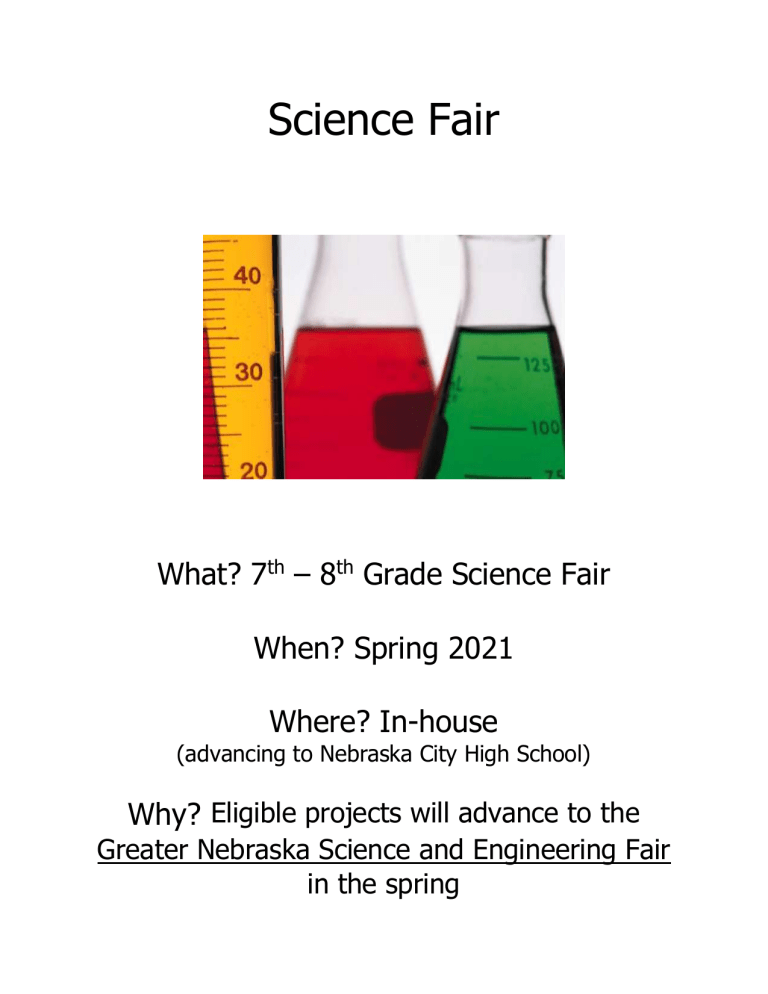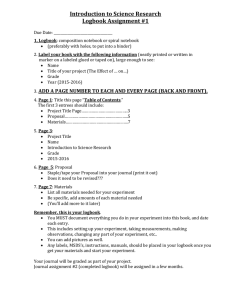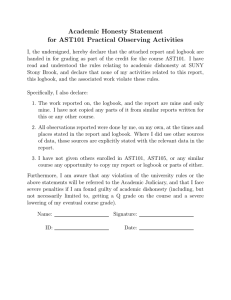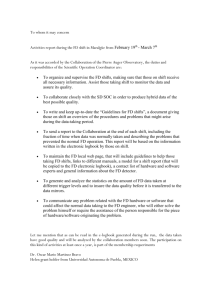
Science Fair What? 7th – 8th Grade Science Fair When? Spring 2021 Where? In-house (advancing to Nebraska City High School) Why? Eligible projects will advance to the Greater Nebraska Science and Engineering Fair in the spring What is science? Why is science important? These two questions need to be considered by anyone who explores the world through a science investigation. Experience shows that the best way to really understand the true nature of science is to become involved in a science investigation from start to finish. Scientific Method – You will be using the following steps to organize your experiment/project. 1. Ask a question. 2. Review what is known about the topic. 3. Formulate a hypothesis. 4. Experiment to test the hypothesis. 5. Observe the experiment; record and organize the results. 6. Analyze the results and draw conclusions. 7. Share the results with others. How do I plan my investigation? – As you plan your investigation, you will need to consider the following questions: *What supplies and equipment will I need in order to complete the steps I plan to follow? *Where will I get the equipment and supplies? *What will I measure to determine the result of my experiment? *What is the control group for my experiment? *What is the variable for my experiment? The Three Major Parts 1. Library Research/Research Paper Library research must be conducted first in order to educate you in the subject you chose for your experiment. The books researched, what you learned, and the bibliographic information should all be recorded in the log book. The results of your library research will be presented in the research paper. This portion of the project is worth 30% of your total grade. 2. The Experiment The most important part of your project is the actual experiment. The data collected, the procedure followed, and the results are all to be recorded in the logbook. The experiment is worth 30% and the logbook is worth 15% of your total grade. 3. The Display The final piece of your project is the display of your results. The display must visibly and clearly communicate the findings achieved. The display board should be an advertisement for your project. The display is worth 25% of your total grade. The Log Book ● Your logbook (composition notebook or spiral notebook) will contain all relative information collected during library research, as well as the data collected during your experiment. It will also contain your thoughts concerning the project and the experimentation process. ● All entries in the logbook should contain the date (and time, if necessary) of each entry. All entries should be written in ink and single-spaced on the front side only of the pages. (If you are using a spiral notebook you may skip lines.) The logbook may not be typed. ● The logbook should be relatively neat and readable, but is not intended to have the appearance of a research paper. ● The log book should be laid out as follows: o Title page o Table of contents (this will develop as the logbook does, so leave some blank pages in the front) o A brief abstract describing the project (again, leave blank pages so you can write the abstract as your project develops) o The major portion of the logbook should be divided among your library research, your experiment and data collected, and the conclusions and findings about the project. o The use of hand-drawn sketches and illustrations is encouraged. o The logbook is the most detailed and comprehensive part of the science project. It is the only part of the project that starts when the topic is chosen and is finished the day you turn in your project. A thorough logbook should be around 30-50 pages. Your Research Paper ● Your paper must contain the following: o Title Page o Table of Contents o Outline o Brief Abstract o Main Body of Paper (introduction, methods and materials, results, conclusion, and discussion) o Bibliography Page (Sources) o The final draft of the research paper should be presented in a folder that will enhance the theme of the paper. ● o and vertically. o information ▪ ▪ ▪ ▪ ▪ ● o outline to create the table of contents. o o heading. Title Page The title page must be centered horizontally The bottom right corner must list the following Your name School name Grade Name of teacher Due date of final version Table of Contents Most students use the major points of their Eight or ten lines is sufficient. Page numbers are used to locate each o Place the title of the project at the top of the page. ● Outline o The normal length of an outline is ½ to 1 page. o Work the main points of your outline into the body of your paper. ● Abstract An abstract that briefly describes the paper should precede the main body of the paper. It should be on a page by itself and be 50-150 words in length. ● Main Body of Paper o Length of paper ▪ Junior High should have a main body length of 7-10 double-spaced typed pages (12 point font) o Be sure to proofread for errors. Use spell check. o Begin numbering with page 2 (introduction). DO NOT place a page number on the first page (abstract). The table of contents and outline are not numbered. Include the bibliography as the last page and number it. o Place numbers on the top right corner or on the bottom center of the paper. o The first page is to be used to define your topic and to state the purpose of the paper (abstract). The purpose should be 2 or 3 sentences that explain the reason why the topic was chosen and also explain what the student expects to discover through the investigation. This page acts as page 1, but you will not place a page number. o Include pictures, graphs, illustrations, etc. in the body of the paper. o The last paragraph must present a conclusion relating the proposed experiment to the research presented. ● Bibliography o Junior High must use a minimum of seven sources, three of which must be considered scientific in nature (books and scientific journals). The remaining references may be encyclopedia, online resources, or other more common resources. o Sources should be current. The Experiment ● Definition o An experiment is a series of tests undertaken in order to verify predicted results. The tests are usually performed in order to prove a hypothesis. o It involves a control or standard to which the “change” can be measured. For example, if you are testing the growth rate of plants that are exposed to classical music, your control would be a plant that is not exposed to the music. o It involves a large population or series of repetition in order to verify the validity of the results. o The data collected, the comparisons made, and the conclusions reached are all recorded in the logbook. ● The Control o The control must be within measurable limits. o Usually the control is accomplished by setting aside or not manipulating some of the population. The changes in the manipulated population can be compared to the unaltered population. ● Repeating the Experiment o An experiment must be conducted several times using the exact same controls in order to validate the results. o If time is a factor, then several simultaneous experiments using the same controls are acceptable. ● Careful attention to detail, especially in the control and repetition of the experiment, is extremely important to a successful project. The Project Display ● Required Display Contents o All display information should be typed, but very neatly hand-written information can be acceptable. The display must have the following items: ▪ Title ▪ Subtitles ▪ Hypothesis ▪ Abstract ▪ Illustration or description of equipment used in experiment ▪ Experimental procedure or method ▪ Results, including graphs or similar illustrations ▪ Conclusions and/or recommendations ▪ The logbook ● Explanation of the Display o Title ▪ should have a professional appearance and be between 1 and 3 inches high. ▪ should be short and to the point (10 words or less). The best titles usually pose a question to be answered or are “catchy.” o Subtitles ▪ should have a professional appearance and be approximately 1” high (smaller than the title). ▪ If you have a “catchy” title, this will be your question. o Purpose ▪ What is your reason for pursuing this project? What did you hope to learn through this investigation? o Hypothesis and/or Problem Statement ▪ The length is usually one sentence or statement. ▪ It is a prediction of the outcome of the experiment. o Abstract ▪ Length: 50-150 words. ▪ Definition: The abstract is a summary of the project. It briefly describes from start to finish the overall significance of the project. o Equipment Description ▪ This may take the form of a drawing, photographs, or actual setup of the equipment used in the experiment. ▪ The purpose is to illustrate the manner in which the experiment was conducted. o Procedure ▪ This is a concise step-by-step record of the manner in which the experiment was conducted. ▪ It is intended to give the observer a general understanding of how the results were obtained. ▪ It should avoid extreme detail. o Results ▪ Tables, graphs, or other visual illustrations are excellent methods of displaying the results of an experiment. Make sure the correct type of graphs are used. Make sure the graphs are sufficiently labeled. ▪ Avoid wordy discussions describing how results were obtained. Make results appear to be obvious. ▪ Basically, what did you learn from your experiment? o Conclusion(s) ▪ The conclusion is similar to the results in that it includes the findings of the experiment, but different in that it extends to the observer suggested applications or benefits of the findings. ▪ It should offer an answer to the original question. Do you accept or reject your hypothesis? ▪ It briefly describes how society may benefit or profit from the results obtained by the experiment. ▪ It may recommend further experimental procedure to be pursued if the results are somewhat inconclusive. Topic List A good science investigation question (1) can be answered by selecting one answer from a few possible answers, (2) involves a topic about which you can find a lot of background information, (3) is something that is easily observed and measured, and (4) leads to an investigation that you can perform with available equipment and other materials. ● Can earthworms be used to recycle kitchen wastes into fertile garden soil? ● The effect of pollution on the buoyancy of freshwater birds. ● What colors attract certain insect pollinators? ● How can plants be used to measure the level of air pollution? ● Which starch plant produces the most fuel? ● Is chlorophyll present in a leaf that has turned brown? ● The effect of the height of a swinging mass on its energy ● How does changing the effort on a third class lever affect the resistance of the load? ● Which grass can withstand drought? ● Is there a way to contain oil that has been spilled on water? ● Is there an environmentally-friendly detergent that can clean oil off of bird feathers? ● Do different brands of orange juice contain different levels of vitamin C? ● Do all plants transpire at the same rate under different sources of light? ● Can you use a cricket to tell the temperature of air? ● How do soil and water compare in their abilities to absorb and release heat? ● Under what conditions do algae grow best? ● How can you tell if sunscreen blocks ultraviolet light? ● Can potatoes complete an obstacle course? ● Do preservatives really stop the growth of bacteria? ● What effect does nicking the seed coat have on the germination rate of seeds? ● Does boiling geranium seeds affect their seed germination? ● What is the effect of vitamin A on regeneration in planaria? ● What is the effect of temperature on the length of time a battery lasts? ● Determination of vitamin C in aging fruit ● Does wind have any effect on the amount of water loss from the leaf surface of a plant? ● Are composites of wood stronger than solid wood? ● Does a golf ball’s bounciness influence the distance that it will travel? ● Test for the hardness of water. ● Can the lifespan of a bubble be extended in different temperatures? ● How can the amount of bacteria found on kitchen sponges and dishcloths be reduced? ● What causes the unequal heating of land? ● How does root position affect plant growth? ● A comparison of the heat-conducting abilities of different metals. ● Can you use insulation materials to keep food fresh? ● Generate electricity for a flashlight without batteries. ● Can orange peels fight off drought? ● Can a robot maintain a vegetable garden? ● The effect of colored light bulbs on the growth of plants. ● Sprout seeds without soil. ● ● ● ● ● ● ● ● ● ● How do glaciers change land? Construct a working dimmer switch. The growth of bacteria in different disinfectants. Mold growth on different types of bread. The effects of salt vs sugar on plant growth. Wavelengths of sound produced by different musical instruments. How can you turn a desert into farmland? Is eye color related to vision? The effects of air drag on cars. Anti-bacterial effect of cranberries. Helpful websites: www.all-science-fair-projects.com www.sciencebuddies.org




